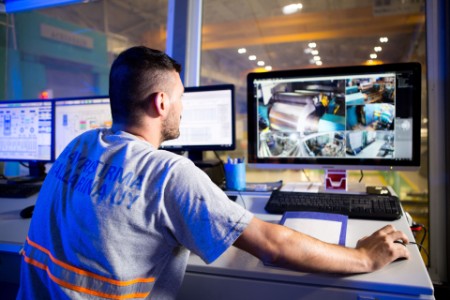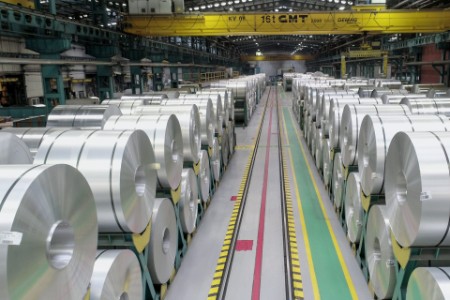
The better the question
How can customer experience forge the links in your supply chain?
As a vital link in other firms’ supply chains, the company needed innovation at scale to improve the customer experience without disruption.
With each passing year, the supply chain is becoming an increasingly indispensable function that has to combine high-level corporate strategy with data operations,” says Goksal Gungor, General Manager, Assan Aluminyum, a leading manufacturer in the global aluminum industry, headquartered in Turkey. “Organizations that don’t see the supply chain as critical in achieving business goals are doomed to fail.”
For Assan Aluminyum, the importance of supply chain management was well-recognized across the company. As a manufacturer of a core manufacturing material, they knew how vital a link they were in their customers’ own supply chains and across their entire business ecosystem’s value chain.
As for so many big industrial manufacturers, their challenge was to find ways to adapt effectively to changing needs while maintaining production and improving both profitability and customer satisfaction. The company needed to demonstrate that despite being transformational, their new approach would not interrupt or break the supply chain.
In reframing their future to be more agile and customer-focused, the Assan Aluminyum leadership team realized they needed an organization that could present a global transformation strategy with a holistic view of Assan Aluminyum’s supply chain. However, this partner would also need to respond to more specific, local needs to address the cross-sector requirements of its customers.
EY’s combination of deep experience in technology-enabled transformation, the manufacturing sector, and local market presence meant we were able to collaborate with Assan Aluminyum to truly reframe its future. We did this by finding ways to innovate at scale, while deploying the most effective and appropriate technologies at speed. At the same time, the needs of humans – both customers and staff – were kept at the center of their thinking.

The better the answer
Put humans and data at the center to create sustainable change
Successful transformation requires the active participation of and actionable insights for the entire organization.
Considering Assan Aluminyum’s core focus on increasing its supply chain’s agility and responsiveness to specific customer needs, the starting point for the EY team may seem counter-intuitive: greater centralization.
“To achieve operational excellence across the supply chain, we first opted to create a centralized infrastructure to integrate business processes,” says Gokhan Gumuslu, Region Management Consultant Leader for EY CESA (Central, Eastern, Southeast Europe and Central Asia) and EY Head of Consulting, Turkey. “This allowed us to monitor operations in a more efficient way and, in turn, enable more effective adaptation to shifting product lifecycle management needs.”
An increased focus on meeting customer needs – to provide a fast and accurate service, accommodate product variations, and offer competitive pricing and information quickly – was supported by a range of digital tools identified and provided via the EY Supply Chain Reinvention Framework and Supply Chain Operating Model methodologies.
These tools helped to:
- Improve inventory visibility and traceability
- Connect the control tower dashboard to multiple systems using a BI Dashboard tool
- Modify the CRM system to support customer recycling for scrap management and efficiency improvement
- Roll out SAP modifications to improve order management and sales management processes
- Produce SAP reports to support product management reporting, data management and data entry forms
- Enhance the procurement system underpinning a centralized structure
Thanks to the team’s Supply Chain Operations experience, we were able to deploy these new technologies and data solutions quickly, rapidly improving Assan Aluminyum’s digital readiness, data quality and analytical capabilities, via real-time data reporting.
Overall, there were five key aspects to the transformation program:
- Improving service levels in the end-to-end management of the sales and supply chain operations, including advanced planning services and integrated planning developments within the company.
- Adopting product lifecycle management by examining and improving product portfolio management to continue launching innovative new products in the market.
- Improving supply efficiency including Assan Aluminyum’s scrap procurement processes, supplier relations and all logistics processes to improve environmental efficiencies.
- Helping to ensure operational excellence by optimizing performance management and use of data.
- Managing transformation with a long-term communications plan to support the transition to a learning organization and adopting a transformational mindset.
Supply chain segmentation
One of the core areas enhanced data insight was deployed was via supply chain segmentation – a central part of Assan Aluminyum’s business strategy. The goal was to support the rapid development of responsive new customer-centric solutions, tailored to each customer’s needs. Together with Assan Aluminyum, the EY team mapped the organization’s customer segments to its operational supply chain category and subsequently prioritized service levels, order methods and cancellations for each customer segment. As a result, customers from the automotive, construction and packaging industries received unique customer service and Assan Aluminyum optimized its capacity usage and prioritization to support the highest return for value delivered.
According to Arda Karacelebi, EY Partner and Supply Chain & Operations Consulting Leader, Turkey, who headed up the project, “with this segmentation infrastructure it was much easier to manage how Assan Aluminyum’s operations aligned with its strategies and customer segmentation preferences, as well as profitability objectives.”
The initial efforts to implement greater centralization of information and oversight was the foundation that would enable greater adaptability so that the strategy would be able to meet the needs of every customer – and employee – by enabling more granular insights and better, more informed decisions.
Putting humans at the center
Focusing on the needs of employees as well as customers was always fundamental to EY’s approach, based around the concept of putting humans at the center. This is because with any major transformation initiative, change management is critical to the success of the project– and keeping people on board is often one of the biggest challenges. “After the design phase, we stayed with Assan Aluminyum for a year to support the implementation and discuss potential improvement opportunities they could consider in the months ahead,” says Gumuslu.
Changing the culture of the company to drive long-term value takes a sustained effort. As people learn new skills, they adopt new behaviors and take a more innovative, effective response to ever-evolving customer needs. This is why, in parallel to the digital technology implementation across the supply chain and customer-centric innovation, EY and the Assan Aluminyum leadership team also collaborated on a sustained internal communication plan. These activities focused on changing the way employees discussed and assessed issues ranging from planning and capacity to costs and margins.
At the heart of this program were two new interdisciplinary teams, transcending internal silos of departments and business units, for both the design and implementation phase of the project. These were supported by a steering committee and change review board. Periodic committee meetings – which also included representatives from the firm’s procurement, IT and audit teams – played a vital role in decision making throughout the project.
In all, we ran more than 200 meetings and 30 workshops, with more than 60 Assan Aluminyum and 20 EY employees, leading to a roadmap containing two projects directly aimed at employees and 13 projects indirectly aimed at increasing their productivity. Together, these initiatives focused on helping to ensure the company became learning-focused, changing how every employee works, and increasing openness to innovation and new ideas.
This also helped instill a sense of ownership and true consultation amongst the teams responsible for the operational processes at the heart of the transformation, and boost communication between different stakeholder groups.
As a result, despite starting out with centralization, Assan Aluminyum’s transformation was achieved not through a top-down approach, but with active, collaborative participation across the entire organization.

The better the world works
Improved efficiency and insight enable greater agility
Improving efficiency alone isn’t enough to drive long-term value. To realize effective transformation means reframing your future.
“Even with business demands increasing, we managed to increase our delivery on time and improve our supply chain response time by 27%,” says Gungor. “These improvements are very important as they directly affect our customers in many positive ways.”
Some key outcomes include:
- Improved operational efficiency and lower operational costs
- More accurate demand planning processes
- More informed discussion of supply chain and operating scenarios by financial impact and contribution
- Lower inventory requirements thanks to end-to-end inventory analysis
- Reduced working capital requirements
- Faster order acceptance, confirmation, and commitment to a promise date
Supply chain response time
27%improvement in spite of increasing business demands.
The collaboration between EY and Assan Aluminyum ultimately transformed far more than the supply chain, instead reshaping the entire organization. With clear communication and a strong working relationship that put humans at the center, applied technology at speed and employed innovation at scale, the project gave rise to a fundamental shift in how Assan Aluminyum operates as an organization. For instance, the improved visibility into supply chain operations has also enabled other positive changes, with Gungor citing a 10% increase in the use of recycled aluminum roll, helping the company get closer to achieving its core sustainability goals.
“These tangible results show that we are on the right track to achieve our goals,” says Gungor. “I’m also very proud to mention another achievement in our supply chain transformation project. The Supply Chain Professionals club – founded by a domestic association in Turkey and several stock organizations – has awarded Assan Aluminyum first place among more than 200 companies in the most innovative project category. Everyone at Assan Aluminyum and our fantastic partner EY has made this achievement possible.”




